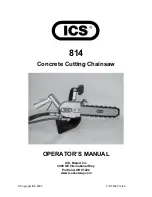
GB
| Operating Instructions
4
highly recommended to use a residual current device (RCD).
The use of an RCD
reduces the risk of electric shock.
3) Personal safety
a) Always pay attention to what you do and apply reasonable care when working
with a power tool. Do not use the power tool when you are tired or under the
influence of medication, drugs or alcohol.
When working with power tools, even a
short moment of inattentiveness may result in severe injury.
b) Wear personal protection equipment and always wear eye protection (safety
goggles).
Wearing personal protection equipment as a dust mask, nonslip safety
shoes, safety helmet or ear protectors (depending on the type and application of the
tool) reduces the risk of injury.
c) Avoid unintentional operation. Make sure that the power tool is switched off
before you connect it to the mains supply and/or the battery and whenever you
pick up or carry the tool.
When carrying the tool with your finger on the on/off switch
or connecting the tool to the mains supply with the switch in ‘ON’ position, this may
result in accidents.
d) Remove adjustment tools or wrenches and the like before you switch the pow-
er tool on.
A wrench or other tool that is inside or on a rotating part of the tool may
cause injury.
e) Avoid unusual postures. Make sure to have a safe footing and keep your bal-
ance at all times.
This will allow you to better control the power tool in unexpected
situations.
f) Wear suitable clothes. Do not wear wide clothing or jewellery. Keep your hair,
clothes and gloves clear of all moving parts.
Loose clothing, jewellery or long hair
may get caught in moving parts.
g)
If dust extraction/collection devices are provided make sure that they are con
-
nected and used properly.
The use of a dust extraction device may reduce risks
caused by dust.
4) Use and handling of the power tool
a) Do not overtax the power tool. Use the power tool intended for your type of
work in each case.
The use of the suitable power tool within the stated range of
performance makes working more effective and safer.
b) Do not use a power tool with a damaged switch.
A power tool that cannot be
switched on or off any more is dangerous and must be repaired.
c)
Pull the mains plug and/or remove the battery before adjusting a tool, changing
accessories or putting the tool aside.
This precaution avoids the unintentional start
of the tool.
d) Store power tools that are currently not used out of the reach of children. Do
not allow persons to use the tool if they are not familiar with the tool or these
instructions.
Power tools are dangerous if used by inexperienced persons.
e) Thoroughly maintain your power tool. Check whether moving parts are working
properly and are not jamming/sticking, and whether parts are broken or oth
-
Summary of Contents for PMAS 750
Page 2: ...1 10 5 6 4 12 9 13 7 8 17 18 19 16 1 1 11 15 3 2 14 20...
Page 3: ..._ 19 18 9 C B D 13 2 7 2 mm 12 13 A 3 2 5 E 9 18 9 4 6...
Page 4: ...3 14 3 11 12 13 2 8 10 MAX MIN 16 10 7 5 9 16 17...
Page 5: ...4 16 15 a b c 14...
Page 50: ......
Page 51: ......














































